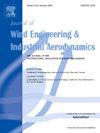利用高斯过程回归快速评估 VIV 条件下大跨度悬索桥上驾驶员的乘坐舒适性
IF 4.9
2区 工程技术
Q1 ENGINEERING, CIVIL
Journal of Wind Engineering and Industrial Aerodynamics
Pub Date : 2025-02-26
DOI:10.1016/j.jweia.2025.106060
引用次数: 0
摘要
涡激振动(VIV)严重影响乘坐舒适性,可能导致交通限制,扰乱经济和社会活动。VIV和交通对乘坐舒适性的综合影响尚未得到很好的理解,现有的研究往往过于耗时,无法及时做出桥梁管理决策。本研究旨在探讨大跨度悬索桥(LSSBs)在振动过程中的乘坐舒适性,并建立一个实时评估的在线预测模型,以帮助桥梁管理决策。建立了涡桥仿真平台,提取车辆动态响应,计算晕动病发生率,评价车辆在涡桥行驶过程中的平顺性。由于交通流的随机性,MSI被概率化处理。利用Jensen-Shannon散度法确定了MSI数据的最优概率分布模型(PDM)。以VIV模式、VIV振幅和交通密度为输入,以MSI的PDM参数为输出,构建了高斯过程回归(GPR)代理模型。利用GPR代理模型对LSSB原型进行了实例研究,深入探讨了VIV模态、VIV振幅和交通密度对MSI的影响。该模型能够及时预测驾驶员在VIV作用下的MSI,有助于有效的桥梁管理决策。本文章由计算机程序翻译,如有差异,请以英文原文为准。
Rapid evaluation of drivers’ ride comfort on long-span suspension bridges under VIV using Gaussian process regression
Vortex-induced vibration (VIV) significantly affects ride comfort and may necessitate traffic restrictions, disrupting economic and social activities. The combined impact of VIV and traffic on ride comfort is not well understood, and existing studies are often too time-consuming for timely bridge management decisions. This study aims to explore ride comfort on long-span suspension bridges (LSSBs) during VIV and develop an online prediction model for real-time evaluations, aiding bridge management decisions. A vortex-traffic-bridge (VTB) simulation platform is established to extract vehicle dynamic responses and calculate motion sickness incidence (MSI) for evaluating ride comfort during VIV. MSI is treated probabilistically due to traffic flow's stochastic nature. The optimal probabilistic distribution model (PDM) for MSI data is identified using Jensen-Shannon divergence. A Gaussian process regression (GPR) surrogate model is constructed with VIV mode, VIV amplitude, and traffic density as inputs, and PDM parameters for MSI as outputs. A case study of a prototype LSSB using the GPR surrogate model thoroughly investigates the influence of VIV mode, VIV amplitude, and traffic density on MSI. This model can timely predict drivers' MSI under VIV, aiding effective bridge management decisions.
求助全文
通过发布文献求助,成功后即可免费获取论文全文。
去求助
来源期刊
CiteScore
8.90
自引率
22.90%
发文量
306
审稿时长
4.4 months
期刊介绍:
The objective of the journal is to provide a means for the publication and interchange of information, on an international basis, on all those aspects of wind engineering that are included in the activities of the International Association for Wind Engineering http://www.iawe.org/. These are: social and economic impact of wind effects; wind characteristics and structure, local wind environments, wind loads and structural response, diffusion, pollutant dispersion and matter transport, wind effects on building heat loss and ventilation, wind effects on transport systems, aerodynamic aspects of wind energy generation, and codification of wind effects.
Papers on these subjects describing full-scale measurements, wind-tunnel simulation studies, computational or theoretical methods are published, as well as papers dealing with the development of techniques and apparatus for wind engineering experiments.

 求助内容:
求助内容: 应助结果提醒方式:
应助结果提醒方式:


